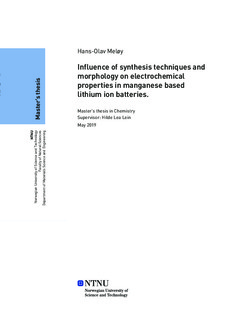| dc.contributor.advisor | Lea Lein, Hilde | |
| dc.contributor.advisor | Vullom-Bruer, Fride | |
| dc.contributor.advisor | Ramleth Østli, Elise | |
| dc.contributor.author | Meløy, Hans-Olav | |
| dc.date.accessioned | 2019-08-25T14:00:47Z | |
| dc.date.available | 2019-08-25T14:00:47Z | |
| dc.date.issued | 2019 | |
| dc.identifier.uri | http://hdl.handle.net/11250/2610728 | |
| dc.description.abstract | Føremålet med denne avhandlinga er syntese av LiMn2O4 med varierande partikkel morfologi, og kva det si påverknad det vil væra for bruk i høg spennings litium ion batteri (LIB).
Gjennom sol-gel syntese og medutfelling vart da vellukka syntetisert fase reint LiMn2O4, og utvalde prøvar vart nytta til å setja saman litium ion half celler.
Eit høgt tall syntesar vart utført for båe sol-gel og medutfelling, som resulterte i eit høgt tall prøvar med ein sekundær fase av Mn2O3. Begge teknikkar viste at dei kunne nyttast til å laga LiMn2O4 med eit utval av ulike morfologiar. Opene svamp likande partikklar, porøse ellipsoidar og prøvar med stor variasjon i partikelstørrelse har vorte laga.
Sol-gel syntesen var enten sitron syre eller Pechini metoden. Endring i båe kalsinerings temperatur og pH-control vart forsøkt. Endring i pH leia ikkje til noko brukbart resultat.
Syntese av LiMn2O4 gjennom medutfelling vart gjort gjennom først utfelling av MnCO3. som alternativt vart varmebehandla for å forma MnO2. Båe MnCO3 og MnO2 vart blanda med LiNO3 etterfølgt av kalsinering. Tre like blande teknikar vart utprøvd, for hånd med mørter og pestel, ball mølling og vatn dispergering. Verken bruk av mortar og pestel og ball mølling gav ønskja fasereine LiMn2O4 men, vatn dispergering oppnådde dette derimot. Analyse av fase reinleiken til alle prøvar vart gjort gjennom røntgen diffraksjon, mens analyse av overflate areal og morfologi gjennom sveipelektronmikroskop.
Utvalde fasereine prøvar frå både sol-gel syntese og medutfellings syntesen vart nytta til å setja samen litium ion halv celler, for å analysera materialets eigenskap før dette føremål. Ein katode slurry vart laga med å blanda \ch{LiMn2O4} pulver med svart karbon, N-metyl-2-pyrrolidon (NEP) of ployvinyldiene flourid bindemiddel i båe 5 % og 10 % forhold etter masse.
Blanda slurry vart smørt ut over ein aluminiumsfolie straum samlar, og katodar av passande størrelse vart kutta ut.
Ferdig framstilte katodar vart saman med ein metallisk litium anode og LiPF6-elektrolytt sett saman til ei halv-celle.
Eigenskapane til dei samansett cellene vart evaluert gjennom galvanostatisk sykling, for å bedømma kapasitet, tap av kapasitet og rate evne. Begge valte materialar hadde låg kapasitet ved start med 81.2 mAh/g for produkt frå sol-gel syntesen og 82.7 mAh/g for produkt frå medutfellinga.
Begge prøvane opplevde raskt tap av kapasitet, og tilnærma inga tilgjengeleg kapasitet ved høge C-rater. Det var lite forskjell mellom produkta som vart testa, men LiMn2O4 frå sol-gel verka som det betre val.
Vidare evaluering av endring i forskjellen mellom sykla og usykla katode vart gjort etter galvanostatisk sykling. Røntgen diffraksjon vart teken av både testa og utesta støypte katodar. Vidare så vart endingar i mikrostrukturen analysert før og etter bruk. | |
| dc.description.abstract | The purpose of this thesis is the synthesis of LiMn2O4 with different morphologies and the impact this have on its use for high-voltage lithium ion batteries (LIB).
Through sol-gel synthesis and coprecipitation, phase pure LiMn2O4were synthesised successfully and selected samples was used in the assembly of lithium ion half cells.
A large number of synthesis with different parameters were completed for both techniques, which resulted in a large number of samples with a secondary Mn2O3 phase. Both techniques showed that they could produce LiMn2O4with a variety of morphologies. Open sponge like structures, porous ellipsoids and particles with wide size distribution have been synthesised.
Sol-gel synthesis was either the citric acid method or Pechini method. Different calcination temperatures were used, as well as some samples with active pH control. Altering the pH of the gel yielded no usable results.
Synthesis of LiMn2O4 through coprecipitation was done through precipitation of MnCO3. Heat treatment of MnCO3 was done to form MnO2 for some samples. Both MnCO3 andMnO2 was attempted mixed with LiCO3 with mortar and pestle, ball milling, and mixing in a water dispersion. Mixing by hand in mortar and pestle and ball milling proved far insufficient to get the desired phase pure LiMn2O4, while the water dispersion technique however provided the desired result.
Phase purity was evaluated through X-ray diffraction. Scanning electron microscopy was used to analyse morphology, and overall surface area was found for selected samples.
Phase pure samples from both techniques was used to assemble lithium ion half cells to evaluate their electrochemical properties. An cathode slurry was prepared by mixing LiMn2O4 powder with carbon black N-Metyl-2-pyrrolidione (NEP) polyvinylidene fluoride binder in both 5 and 10 % by weight. The slurry was casted on a aluminium foil current collector, and cathodes cut from the foil.
Prepared cathodes were assembled into lithium ion half cells in a glove box in a inert argon atmosphere, alongside a metallic lithium anode and \ch{LiPF6} electrolyte.
The properties of the assembled cells were tested through galvanostatic charge-discharge cycling, to evaluate capacity, capacity loss and rate capability. Both materials had a low initial capacity of 81.2 mAh/g for sol-gel synthesised LiMn2O4 and 82.7 mAh/g for coprecipitated synthesis LiMn2O4. Both samples experienced rapid capacity fading, and next to no available capacity at high C-rates. There was only marginal difference between tested samples, but the sol-gel synthesis seemed superior.
Some evaluation of changes in the cathode cast was done following galvanostatic cycling. X.ray diffraction was taken of cycled and non-cycled casted cathode. And investigation into the surface microstructure was also done. | |
| dc.language | eng | |
| dc.publisher | NTNU | |
| dc.title | Influence of synthesis techniques and morphology on electrochemical properties in manganese based lithium ion batteries. | |
| dc.type | Master thesis | |
